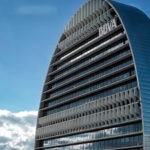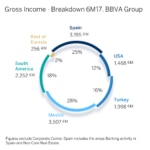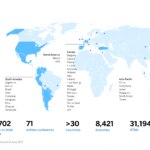BBVA earns €2.31 billion in first half (+25.9%)
- Income: Net interest income reached a seven-quarter high in Q2. In the year to June, this item, plus fees and commissions, grew 5.1% y-o-y. This, combined with cost-containment efforts, helped keep the efficiency ratio at levels below 50%
- Risks: The Group’s NPL ratio stood at 4.8% at the end of the quarter, compared to 4.9% in December; coverage stood at 71%
- Capital: BBVA remained in line with its fully-loaded CET1 target (11%). It added 20 basis points in the first two quarters and increased the ratio to 11.10%. This ratio includes the negative impact related to the March purchase of an additional 9.95% stake in Turkey’s Garanti
- Transformation: As of the end of June, BBVA’s digital customer base came to 19.9 million (+22% y-o-y). Of these, 14.5 million were mobile customers (+42% y-o-y). BBVA’s mobile banking app in Spain is the best in the world, according to Forrester Research

Between January and June 2017, BBVA Group posted a net attributable profit of €2.31 billion, up 25.9% from the same period a year earlier (+30.8% in constant terms). The solid performance of recurring revenues, moderation in operating expenses and a drop in impairment losses on financial assets are the main factors that supported this growth.
BBVA CEO Carlos Torres Vila said that “the second quarter results confirm the positive trends recorded earlier this year, both in terms of financial results and of transformation and value creation for shareholders.”
Q2 net interest income reached a seven-quarter high (€4.49 billion). During the first half of 2017, this item stood at €8.8 billion (+5.2% y-o-y, +9.6% stripping out the currency impact). Fees and commissions were favored by the recovery of activity in wholesale businesses. This item grew 4.5% y-o-y (+8% at constant exchange rates) to €2.46 billion.
Gross income stood at €12.72 billion, up 4.0% y-o-y (+7.8% at constant exchange rates), driven mainly by growth in recurring revenues (net interest income plus fees and commissions), which rose 5.1%, or 9.2% stripping out the exchange rate effect.
During the first half of the year, the impact of cost-containment efforts through efficiency plans, along with the materialization of certain synergies became evident. All this allowed the efficiency ratio to end under the 50% threshold (49.6%). This ratio is significantly better than the average for BBVA’s European peers (65.6% according to the latest information available for Q1-17).

In this context, operating income reached €6.41 billion, with a growth of 8.6% compared to the previous year (+13.9% excluding the exchange rate effect).
On the other hand, risk indicators improved during the first six months of the year. The non-performing loan portfolio dropped significantly by over €800 million during the quarter (mainly in the Non-Core Real Estate area). In June, the NPL ratio stood at 4.8% (vs. 4.9% in December 2016) and coverage at 71% (it was at 70% in December). The cost of risk remained at 0.9%.
In terms of capital adequacy, BBVA improved its fully-loaded CET1 ratio by 20 basis points during the first half of the year, to 11.10%, in line with its target (11%). This ratio includes the negative impact related to the March purchase of an additional 9.95% stake in Turkey’s Garanti. The fully-loaded leverage ratio stood at 6.8%, the best among European peers.
In terms of activity, gross lending to customers grew 1% in constant terms (-1.4% including the impact of exchange rates), compared to last December. Lending volumes increased in emerging markets as deleveraging in Spain and the United States continued. As of June 30, this item stood at €424.41 billion. Customer deposits decreased slightly over the six-month period (-1.7%) to €394.63 billion.
Lending as part of the banking activity in Spain (performing loans under management) grew 0.7% compared to March. In the first half of 2017, performance was particularly positive in new production of loans to companies (+12.8% y-o-y) and consumer loans (+24%). In Spain, customer deposits rose 1.4% in Q2-17, compared to the previous quarter. At the end of June, deposits maintained the level seen in December 2016.
The bank’s transformation
BBVA’s mobile banking app in Spain was singled out as the best in the world by Forrester Research. At the end of June, BBVA had 19.9 million digital customers (+22% more than in June 2016). Of these, 14.5 million were mobile customers, a 42% y-o-y increase.
Digital Customers
With exponential growth across different regions, the bank is delivering on goals to boost digital sales across all franchises. In the group as a whole, transactions through digital channels increased significantly (from 16.8% in average in 2016 to 22.2% between January and June 2017). The trend has remained the same across all regions. In Spain, the percentage of transactions conducted through digital channels was 24.7%, compared to 2016 average of 17.1%. In Turkey, the market where digitization has the biggest impact, the percentage stood at 31%, from 25.2% in 2016. In the year to June, in the U.S. these sales represented 22.2%, in South America, 22.5%, and in Mexico, 16.0%.
The key developments in each business area are detailed below.
Once again, banking activity in Spain showed its resilience in an environment with interest rates at all-time lows. Net interest income from January through June decreased 3.9% on a y-o-y basis, mainly due to sales of wholesale portfolios. On the other hand, the positive contribution of wholesale businesses underpinned the recovery in fees and commissions, which grew 3% y-o-y during the six-month period. NTI contribution decreased 18.5% compared to the H1-16, which was boosted by the capital gains resulting from the VISA deal. The operating expenses item continued declining (-4.4% over the past 12 months), driven by the synergies resulting from the integration of Catalunya Banc and the implementation of efficiency plans. Impairment losses on financial assets continued declining significantly (-40.6% y-o-y in the year to June). Regarding asset quality indicators, the NPL ratio closed at 5.7% in June (compared to 5.8% in December), with coverage ratio remaining stable at 53%. Net attributable profit reached €670 million, an 8.0% increase compared to the first half of the previous year.
The Non-Core Real Estate area decreased its net exposure to the real estate sector by 14.2% in the last six months. BBVA Group’s strategy is aimed at accelerating sales and reducing stock, capitalizing on the recovery of the real estate market. This business area kept narrowing losses and posted a cumulative result through June of €-191 million.
To better explain the business trends in the areas that use a currency other than the euro, the variation rates described below refer to constant exchange rates.
In the United States, the strategic focus on selective and profitable growth in lending and on reducing the cost of deposits, as well as the increases in interest rates, drove net interest income up (13.6% y-o-y in cumulative terms through June). Favorable cost trends (+1.4% y-o-y), on top of the positive performance of fees and commissions (+7.6% y-o-y), allowed the area to post ‘positive jaws’, i.e. y-o-y gross income growth (+7.3%) exceeded the increase in operating expenses. Operating income grew 19.9% compared to the same period of the previous year. On the other hand, asset quality in the area also evolved positively: the NPL ratio stood at 1.3% in June, with coverage ratio closing at 105%. From January through June, the area’s net attributable profit reached €297 million, up 62.4% from the same period of 2016.
In Mexico, activity grew at high single-digit rates during the six-month period. Net interest income grew by 9.2% y-o-y and fees and commissions rose 11.7%. Cost-containment efforts kept expense growth well under the increase in gross income, resulting in y-o-y operating income growth of 14%. Regarding asset quality, the main risk indicators remained stable: NPL and coverage ratios closed at 2.3% and 126%, respectively, in June. Mexico’s result in the first half of 2017 reached €1.08 billion, with a y-o-y growth rate of 16.4%.
Regarding Turkey, it is worth noting that, in March, BBVA increased its stake at the Turkish bank to 49.85%. This additional increase generated a positive impact of approximately €54 million in the results. Also, the area saw very solid activity during the first six months of the year, which, in combination with a good management of customer spreads against a backdrop of high interest rates, drove net interest income up 21.3%. Fees and commissions, on the other hand, grew 8.4%. NTI contribution also declined y-o-y in this area (-91.6%), essentially as a result of the capital gains generated in the first half of 2016 derived from the VISA deal. All in all, gross income grew 12.1% compared to the same period of the previous year. The operating income increased 12.6% compared to the six first months of the previous year. Asset quality also behaved positively. The NPL ratio fell to 2.5% in June (compared to 2.7% in December) and remained well below the sector’s average, with coverage ratio closing at 135% (versus 124%). Turkey’s net attributable profit jumped 39.3% y-o-y to €374 million.
In South America, activity continued growing, both in terms of lending and customer funds. H1-17 net interest income grew 10.3% y-o-y, while fees and commissions jumped 15.3%. The good behavior of both items explains the double-digit growth in gross income during H1-17 (+10.3% y-o-y). Expenses grew 11.4% y-o-y, in line with high inflation rates in some countries, such as Argentina. Operating income for the H1-17 increased by 9.4% y-o-y. Regarding asset quality, the NPL ratio ended at 3.5% and coverage closed at 94%. The area earned €404 million between January and June, down 3% from the same period of 2016.
About BBVA

BBVA is a customer-centric global financial services group founded in 1857. The Group is the largest financial institution in Spain and Mexico and it has leading franchises in South America and the Sunbelt Region of the United States; and it is also the leading shareholder in Garanti, Turkey’s biggest bank for market capitalization. Its diversified business is focused on high-growth markets and it relies on technology as a key sustainable competitive advantage. Corporate responsibility is at the core of its business model. BBVA fosters financial education and inclusion, and supports scientific research and culture. It operates with the highest integrity, a long-term vision and applies the best practices.